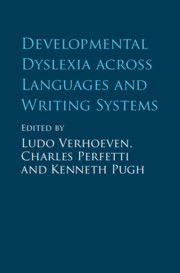Book contents
- Developmental Dyslexia across Languages and Writing Systems
- Developmental Dyslexia across Languages and Writing Systems
- Copyright page
- Contents
- Figures
- Tables
- Contributors
- 1 Introduction
- Part I Developmental Dyslexia across Languages and Writing Systems
- 2 Developmental Dyslexia in English
- 3 Developmental Dyslexia in French
- 4 Developmental Dyslexia in Dutch
- 5 Developmental Dyslexia in Czech and Slovak
- 6 Developmental Dyslexia in Finnish
- 7 Developmental Dyslexia in Russian
- 8 Developmental Dyslexia in Hebrew
- 9 Developmental Dyslexia in Japanese
- 10 Developmental Dyslexia in Chinese
- Part II Cross-Linguistic Perspectives on Developmental Dyslexia
- Epilogue
- Index
- References
5 - Developmental Dyslexia in Czech and Slovak
from Part I - Developmental Dyslexia across Languages and Writing Systems
Published online by Cambridge University Press: 27 September 2019
- Developmental Dyslexia across Languages and Writing Systems
- Developmental Dyslexia across Languages and Writing Systems
- Copyright page
- Contents
- Figures
- Tables
- Contributors
- 1 Introduction
- Part I Developmental Dyslexia across Languages and Writing Systems
- 2 Developmental Dyslexia in English
- 3 Developmental Dyslexia in French
- 4 Developmental Dyslexia in Dutch
- 5 Developmental Dyslexia in Czech and Slovak
- 6 Developmental Dyslexia in Finnish
- 7 Developmental Dyslexia in Russian
- 8 Developmental Dyslexia in Hebrew
- 9 Developmental Dyslexia in Japanese
- 10 Developmental Dyslexia in Chinese
- Part II Cross-Linguistic Perspectives on Developmental Dyslexia
- Epilogue
- Index
- References
Summary
Two small, closely related countries in Central Europe, the Czech Republic and Slovakia, have enjoyed a recent surge in research activities, at the national and international levels, in the areas of typical and atypical literacy development. Many new and exciting findings are informing developments in diagnosis, assessment, and educational policy regarding the prevention and remediation of literacy problems due to dyslexia. In the present chapter, we review much of this recent work. Despite their historical, geopolitical, cultural, and linguistic connections – having existed as a single country for seventy-five years (1918–1993) – the Czech and Slovak countries and their languages are nevertheless distinct. We therefore take a comparative approach throughout the chapter, contrasting the findings in these languages with each other as well as with findings from English and other languages.
- Type
- Chapter
- Information
- Developmental Dyslexia across Languages and Writing Systems , pp. 96 - 117Publisher: Cambridge University PressPrint publication year: 2019
References
- 5
- Cited by

